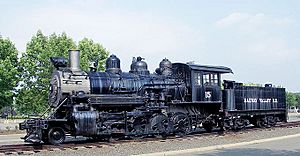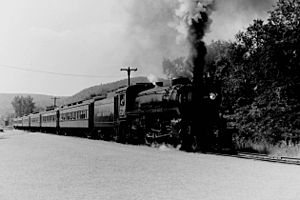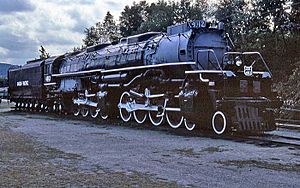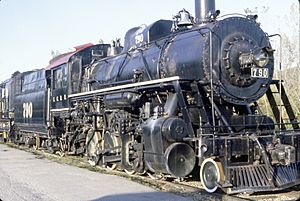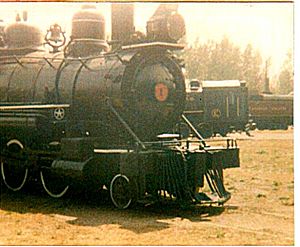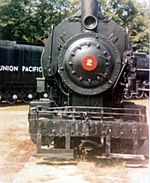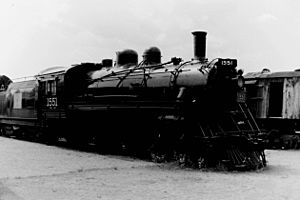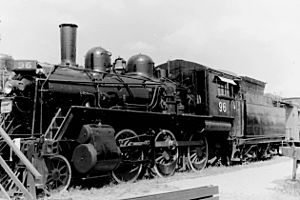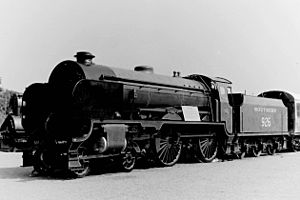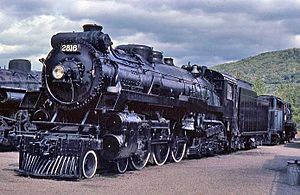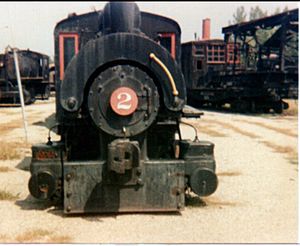Steamtown, U.S.A. facts for kids
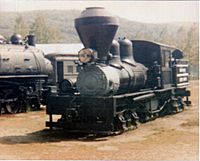
Meadow River Lumber Company Shay #1 on static display at Steamtown, Bellows Falls, Vermont, ca. 1974
|
|
| Established | 1963 |
|---|---|
| Dissolved | 1983 |
| Location | Bellows Falls, Vermont |
| Type | Steam locomotive and other rail equipment |
Steamtown, U.S.A. was a special museum for steam locomotives. It offered fun train rides in North Walpole, New Hampshire, and Bellows Falls, Vermont. This museum operated from the 1960s until 1983.
A rich seafood businessman named F. Nelson Blount started Steamtown. After he passed away in 1967, a non-profit group called the Steamtown Foundation took over.
Over time, Steamtown faced problems. Vermont had strict rules about air pollution from steam trains. Also, fewer visitors came, and there were disagreements about using the train tracks. Because of these issues, some of the train collection moved to Scranton, Pennsylvania in the mid-1980s. The rest of the trains were sold.
Even in Scranton, Steamtown struggled to attract enough visitors. It faced money problems and had to sell more trains to pay off its debts.
In 1986, the United States House of Representatives decided to help. They approved $8 million to study the train collection. This was the first step to making Steamtown a National Historic Site. The National Park Service (NPS) then researched each train. This research helped decide which trains should be part of the new government-funded collection.
By 1995, the NPS had bought and developed Steamtown. This cost about $66 million. Some trains were removed from the collection during this process. Today, part of F. Nelson Blount's original collection is still on display at the Steamtown National Historic Site in Scranton.
Contents
- History of Steamtown
- The Train Collection
- Other Trains in the Blount Collection
- Union Pacific 4012
- Meadow River Lumber Company No. 1
- Illinois Central No. 790
- Brooks-Scanlon Corporation No. 1
- Simons Wrecking Company No. 2
- Canadian National Railways No. 1551
- Canadian National Railways No. 96
- Southern Railway No. 926; Repton
- Canadian Pacific Railway No. 2816
- Bullard Company No. 2
- Union Pacific Railway No. 737
- Accidents
History of Steamtown
How the Collection Started
F. Nelson Blount loved railroads. He was the heir to a large seafood company. When he was only seventeen, he even wrote a book about steam power. In 1955, he bought the Edaville Railroad in Carver, Massachusetts. This was the start of him gathering one of the biggest collections of old steam locomotives in the United States.
Blount also ran train rides at other places. These included Pleasure Island in Wakefield, Massachusetts, and Freedomland U.S.A. in New York City. By 1964, his collection in North Walpole, New Hampshire, had 25 steam locomotives. These trains came from the United States and Canada. He also had 10 other locomotives and 25 train cars.
In 1961, Blount created a company called Monadnock, Steamtown & Northern Railroad. This company was meant to run the tourist trains for his planned museum, Steamtown U.S.A. Blount wanted to open Steamtown in North Walpole. He planned to run train rides to Keene. However, problems with the railroad workers changed his plans.
Blount then made a deal to use 18 miles of track in New Hampshire. The train rides started on July 22, 1961. They used a former Canadian National Railway steam locomotive, #47. The rides also used old Boston & Maine wooden passenger cars. This steam train operation ended early on August 25. The locomotive needed repairs because of missing maintenance papers.
In 1962, the Monadnock, Steamtown & Northern Railroad ran trips between Keene and Gilboa. Blount almost made a deal with New Hampshire. He would donate 20 locomotives if the state funded a Steamtown USA in Keene. This idea was popular in Keene. However, the new governor rejected the plan in 1963.
In 1963, the "Steamtown Foundation for the Preservation of Steam and Railroad Americana" was officially formed. This was a non-profit group. F. Nelson Blount was one of its founders. Other founders included former New Hampshire governor Lane Dwinell and Keene Mayor Robert L. Mallat Jr. Thomas P. Salmon, who later became Vermont's governor, was also a founder.
Steamtown U.S.A. opened as a museum for the first time in 1963. The Monadnock, Steamtown & Northern Railroad ran trips again. These went from North Walpole to Westmoreland. Blount also started talking with Vermont officials. He wanted to use the tracks of the former Rutland Railroad, which was closing down. The Steamtown Foundation's first goal was to move Blount's collection from North Walpole. They wanted to move it to a new location called "Riverside" in Vermont. This new spot was near Bellows Falls, across the Connecticut River.
In 1964, Blount started the Green Mountain Railroad. This company took over freight duties on the old Rutland line. The Monadnock, Steamtown & Northern Railroad began running excursions on these tracks in 1964. Freight service started in April 1965. Meanwhile, parts of the Steamtown collection began moving from North Walpole to Riverside.
Steamtown in Vermont
F. Nelson Blount died in a plane crash on August 31, 1967. By then, much of his collection was owned by the Steamtown Foundation. It had also been moved to Riverside. The Green Mountain Railroad controlled the tracks that Steamtown used for its trips. After Blount's death, the Green Mountain Railroad temporarily took over the passenger train operations. The Monadnock, Steamtown & Amusement Corporation stopped operating in December 1967.
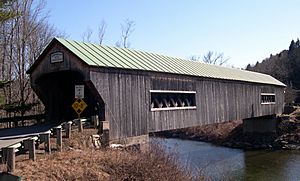
While in Vermont, Steamtown offered many train rides. These usually happened in the summer and during the beautiful fall foliage season. Sometimes, the trips were very long, like one from Boston to Montreal. Daily trips ran from Riverside station in Bellows Falls to Chester depot.
In 1977, a trip cost $5.75 for an adult and $2.95 for a child. This price included entry to the museum grounds at Riverside station. The station was about 2 miles (3.2 km) outside of town. It was located by the Connecticut River. A travel writer named Bill Rice described the 13-mile (21 km) trip to Chester. He said it offered "a beautiful view of unspoiled Vermont countryside." This included covered bridges, old farms, and a winding river with a deep gorge and waterfall. The river he mentioned was the Williams River. The train route crossed it seven times. The waterfall was at Brockway Mills Gorge. It was seen from a bridge 100 feet (30 m) above the gorge. Rice also noted that in 1977, Steamtown had the largest collection of steam locomotives in the world.
In 1971, Vermont's Board of Health allowed the Green Mountain Railroad to operate steam trains. This waiver permitted the trips between Steamtown's Riverside station and Chester. In 1974, Vermont was getting ready to celebrate the country's 200th birthday. The Steamtown train rides were a big part of this. The issue of air pollution rules came up again. Steamtown was operating with temporary permits. By 1976, the relationship between Steamtown and the Green Mountain Railroad worsened. They argued about maintaining the tracks, which Vermont owned.

By 1978, the Steamtown Foundation started looking for a new home for Steamtown, U.S.A. Orlando and other places in Florida were considered. In 1980, the chairman of the Steamtown Foundation resigned. He said the board was not doing a good job. Another long-time director also resigned. The next year, Steamtown did not run any train rides. The new director, Don Ball Jr., found that the trains did not meet federal safety rules.
In 1981, Steamtown, U.S.A. had only 17,000 visitors. This was despite its huge collection of old trains. In comparison, Connecticut's Essex Valley Railroad, which used two small engines, had 139,000 visitors. Even in its best year, 1973, the Vermont location only attracted 65,000 visitors.
A newspaper writer named Michael McManus wrote about Steamtown in March 1982. He suggested that cities like Chicago, Pittsburgh, or Scranton would benefit from a tourist attraction like Steamtown. McManus explained why the business was failing in Vermont. He listed reasons like poor management in the past and a remote location. Also, there were no signs on Interstate 91 due to state opposition.
In addition, the roof of the largest storage building at the site collapsed. This happened under heavy snow the previous winter. Several trains were damaged, including Canadian Pacific Railway No. 1293 and the Meadow River Lumber Company No. 1 Shay (shown in the infobox).
When asked about the value of the Steamtown collection, Jim Boyd, editor of Railfan magazine, said it was priceless. He mentioned trains like the "Big Boy" Union Pacific No. 4012. He also noted the Rahway Valley No. 15, which any museum would want. He said most other large collections did not have working trains. McManus ended his argument for moving Steamtown by saying it was about more than tourism and jobs. He said it was about saving an important part of America's past.
In June 1983, McManus wrote that Scranton had decided to take his suggestion. Other cities considered were Springfield, Massachusetts, and Willimantic, Connecticut. On May 24, Scranton signed a contract. They promised to raise $2 million to move 40 old steam engines and 60 cars. Few of these trains were working. Scranton also planned to create a museum. Steamtown ran its last Vermont trip on October 23, 1983. Canadian Pacific 1246 pulled a dozen cars on a 100-mile (160 km) round trip. This trip went from Riverside station to Ludlow, Vermont.
Steamtown in Scranton and Nationalization
When Scranton agreed to take Steamtown, U.S.A., they thought it would bring many visitors. Estimates were between 200,000 and 400,000 people each year. The city and a private company spent $13 million to fix up the old Delaware, Lackawanna and Western Railroad (DL&W) station. They turned it into a Hilton hotel. At that time, 13 percent of people in Scranton were unemployed.
However, only 60,000 visitors came to Steamtown in 1987. The train rides for 1988 were canceled. After just three years, Steamtown was $2.2 million in debt. It was close to going bankrupt. One problem was the high cost of fixing the new property and the old trains. Also, the train ride in Scranton was not as scenic as in Vermont. The Vermont trip had beautiful farms and covered bridges. The Scranton trip to Moscow, Pennsylvania, went through a very large junkyard.
In 1986, the U.S. House of Representatives approved $8 million. This money was to study the collection and start making it a National Historic Site. This was pushed by Representative Joseph M. McDade from Scranton. By 1995, the National Park Service (NPS) had bought and developed Steamtown. The total cost was $66 million. It opened as Steamtown National Historic Site that same year.
To prepare for this, the NPS researched the trains in 1987 and 1988. This research helped create a plan for the Steamtown National Historic Site. It was published in 1991 as the Steamtown Special History Study. This report gave short histories of each train. It also suggested which trains should be part of the government's collection. A key factor was how important each train was to United States history. Many trains that did not meet these recommendations were sold or traded. They were exchanged for trains that were important to the DL&W grounds where the site is located.
The Train Collection
Before moving to Scranton, Steamtown sold some of its trains. After the government took over, more trains were sold or traded. This was done to get trains that were important to the Scranton area. Below are some examples of the original collection. Some of these trains are still in Scranton, but many are not. We'll share the latest information on where these trains are now.
Trains That Ran in Bellows Falls
Rahway Valley No. 15 was built in June 1916. It is a 2-8-0 Consolidation type locomotive. It was first built for the Oneida & Western Railroad. It was number 20 for that company. This railroad helped develop the coal and lumber industry in Tennessee.
In the mid-1930s, the Rahway Valley Railroad in New Jersey bought this engine. It was renumbered 15. This locomotive mainly worked when the company's other trains were being fixed. It was a favorite of the master mechanic, Charles Nees. When it was retired in 1953, No. 15 was stored safely. F. Nelson Blount bought it in 1959.
Blount first used No. 15 for display at Pleasure Island. Then, it ran train rides in New Hampshire and Vermont from 1962 to 1967. It was used again at Steamtown in 1973. During a trip, it had a problem with its flue. This incident injured engineer Andy Barbera. No. 15 needed repairs, but they were not done for a long time. While Blount owned it, the locomotive appeared in the movie The Cardinal (1963). The Steamtown Special History Study suggested fixing it up. This was because it had worked in the northeastern U.S. and had been serviced in Scranton. As of March 2012, the locomotive is still displayed at Steamtown National Historic Site.
Canadian Pacific Railway No. 1293 was built in 1948. It was retired after only eight years because diesel trains became popular. This was one of three 4-6-2 "Pacific" type locomotives that worked at Steamtown in Bellows Falls. Blount bought it in January 1964. The Steamtown Foundation bought it in 1973 and rebuilt it in 1976.
It started running trips in June 1976. It was painted green and black. No. 1293 served Vermont as its "Bicentennial Train." It traveled 13,000 miles (21,000 km). Vermont leased it for 80-mile (130 km) trips all year. The engine was called "The Spirit of Ethan Allen".
In 1979, the locomotive was renumbered "1881." It was painted black with silver stripes. A Hollywood company leased it for the horror movie Terror Train (1979), starring Jamie Lee Curtis. In 1980, it was repainted with colors Canadian Pacific used in the 1930s. This black, gold, and Tuscan red paint job was popular. The number 1293 was also put back on the engine. In February 1982, the roof of a Steamtown storage building collapsed. This damaged the headlights, handrails, and cab roof of 1293.
The Steamtown Special History Study said this type of train had worked in New England. So, it qualified to be part of the government's collection. However, the Canadian train sat unused for 12 years after moving to Scranton. The Ohio Central Railroad System bought it in 1996. It took 13 months to restore it. As of July 2010, the Ohio Central Railroad has changed hands. But the former owner, Jerry Joe Jacobson, still has a collection of old trains. This includes CPR 1293 and its sister, CPR 1278. No. 1293 was still working as of October 2011.
Canadian Pacific Railway No. 1278, like its sister CPR 1293, was also built in 1948. It is a 4-6-2 "Pacific" locomotive. Blount bought it in May 1965 and renumbered it 127. Blount planned to renumber all three of his 1200 series Canadian Pacific trains. But 1278 was the only one that changed. The new number stayed until 1973, when its original number was put back. The train was leased to the Cadillac and Lake City Railroad in Michigan from 1970 to 1971. After some repairs, it returned to Bellows Falls for train rides.
After moving to Scranton, CPR 1278 was traded to the Gettysburg Steam Railroad. On June 16, 1995, an explosion in its firebox injured three crew members. One man, James Cornell, was seriously hurt. The train had 310 passengers, but none were injured. An investigation found that poor maintenance caused the accident. Jerry Jacobson, owner of the Ohio Central Railroad, bought the engine in 1998. He still owns it. As of 2009, it is stored at Jacobson's Age of Steam Roundhouse in Sugarcreek, Ohio.
Canadian Pacific Railway No. 1246 was the third of the 1200 series Canadian Pacific trains. In the fall of 1983, Steamtown said "farewell to Vermont." They offered two 100-mile (160 km) trips. These trips went "through a landscape of covered bridges, rushing streams and scenic countryside." The train could hold 800–1000 passengers. CPR 1246 was built in 1946 and is a 4-6-2 type locomotive.
After working at Steamtown in Scranton from 1984 to 1986, it was decided that 1246 was not good enough. It was "too light for the heavy grades and sharp curves of the Steamtown line." The National Park Service sold it to the Connecticut Valley Railroad Museum in 1988. This train was on display from 1996 to 2008 at the Valley Railroad in Essex, Connecticut. In 2008, it moved to the Naugatuck Railroad. This railroad is run by the Railroad Museum of New England in Thomaston, Connecticut.
Other Trains in the Blount Collection
Union Pacific 4012
"Big Boy" is a 4-8-8-4 type locomotive. It was built in November 1941. It is one of the world's largest steam locomotives, weighing 1,250,000 pounds (570,000 kg). The Steamtown Special History Study suggested that 4012 stay at Steamtown. It is the only articulated type in the collection. The study also said it should remain on display. It was doubtful that the tracks and bridges could hold its huge weight.
Since the Steamtown turntable and roundhouse were too small, Big Boy 4012 has stayed outdoors since it arrived in Scranton. It is still on display today. From 2019 to 2021, the locomotive was cleaned up to look its best. Besides 4012, seven other Union Pacific Big Boys still exist. One of them, number 4014, was restored in 2019. It is now the largest active steam engine in the world.
Meadow River Lumber Company No. 1
While at Steamtown, the Shay locomotive was badly damaged. The building it was stored in collapsed under heavy snow in February 1982. The Shay's wooden cab was destroyed. However, some parts like its sand dome and headlight were already missing before this. It was decided that it would stay at the National Historic Site. This is because it was the only Shay and the only geared locomotive in the collection.
Illinois Central No. 790
This locomotive was built in 1903. It is a 2-8-0 Consolidation type. It was first owned by Chicago Union Transfer Railway and numbered 100. It was sold to Illinois Central Railroad Company in 1904 and renumbered 641. This railroad operated 4,265 miles (6,864 km) of track. It connected Chicago, Illinois and New Orleans, Louisiana. This train pulled heavy freight in Tennessee. It was likely used a lot. The Illinois Central rebuilt it in 1918, making it more modern.
In 1943, it was renumbered 790. It stayed in service until diesel-electric trains replaced it. It was then stored. However, the railroad still had to use No. 790 in the spring. It helped trains get through flooded tracks near Cedar Rapids. Diesel-electric trains would short out in water. But steam locomotives had their firebox much higher above the rails, so they could handle floods.
Louis S. Keller bought it in 1959. He hoped to use it for train rides. It was used for "flood duty" in April 1965. It plowed through floodwaters from the Mississippi River. Later that year, it was sold to David de Camp. He planned to use it near Lake Placid, New York. Those plans didn't work out. F. Nelson Blount bought it in January 1966.
No. 790 is the only surviving train of the Chicago Union Transfer Railway. It is also the only Illinois Central 2-8-0 Consolidation type of its kind left. About 146 standard gauge 2-8-0s still exist in the United States, including Illinois Central No. 790. The Steamtown National Historic Site kept this locomotive. This was based on the suggestion of the Steamtown Special History Study.
Brooks-Scanlon Corporation No. 1
No. 1 was once part of the Steamtown, U.S.A. collection. This type of train was first used on flat lands like the Great Plains in Kansas. So, it was called a Prairie-type locomotive. Prairie locomotives were later used by lumber companies on flat forest land. This train was built specifically for the lumber industry. It worked for several lumber companies in Florida.
The Carpenter-O'Brien Lumber Company ordered this train in 1913. It was built in 1914. Locomotive No. 1 started working at the company's Eastport sawmill in Florida. This train could burn either coal or wood. It likely had a special smokestack to catch cinders.
After the United States entered World War I in 1917, the Carpenter-O'Brien Lumber Company was sold. It became part of the Brooks-Scanlon Corporation. By 1928, Brooks-Scanlon was working in four Florida counties. They produced 100,000,000 board feet (240,000 m3) of lumber. This train was probably used to haul logs to the mill or move cars around the Eastport plant. In the following years, the train changed owners several times. It was passed between different Florida lumber companies.
In 1959, locomotive No.1 stopped working for its owner, Lee Tidewater Cypress. F. Nelson Blount bought it in 1962. It was moved to Walpole, New Hampshire. Then, it went across the Connecticut River to Bellows Falls, Vermont. It stayed there until Blount's collection moved to Scranton, Pennsylvania.
Simons Wrecking Company No. 2
Simons Wrecking Company No. 2 is a small H.K. Porter, 0-6-0T steam engine. It was built in 1941. This oil-fired tank engine worked for the US Navy during World War II. It was number 14 in Virginia. Later, it worked for Simons Wrecking Co. as No. 2.
This train was once part of Blount's Steamtown collection. But it was sold before Steamtown moved to Scranton. It sat for many years in a car junkyard in Newbury, Massachusetts. In 2006, Dick Carnevale, a Public Works Director, removed the engine from the junkyard. He started fixing it up. He hoped it would be displayed in a city park in Peabody. Carnevale and volunteers restored the engine. After he resigned in October 2008, the city told him to remove the engine. Local residents contacted the Friends of Valley Railroad. They bought the engine and moved it to Connecticut. Today, the locomotive is on display at Essex Steam Train and Riverboat.
Canadian National Railways No. 1551
No. 1551 is a 4-6-0 type locomotive. It was built in March 1912. It was first numbered 1354 for the Canadian Northern Railway. This train was mainly used on Canadian commuter lines. It was renumbered 1551 in October 1956 and retired in 1958. Blount bought the engine in 1961. Restoration began but was never finished.
In 1986, Jerry Joe Jacobson traded another train for No. 1551. It was restored and ran trips for the Ohio Central Railroad. Jacobson lost control of the railroad in 2008. But he still owns the locomotive. It is stored at Jacobson's "Age of Steam Roundhouse" in Sugar Creek Ohio.
Canadian National Railways No. 96
Canadian National Railways No. 96, a 2-6-0 Mogul type, is also owned by Jerry Joe Jacobson. It was built in 1910. It was first numbered 1024 for the Grand Trunk Railway. Then it became 926 when Canadian National got it in 1923. CN renumbered it 96 in 1951. Blount bought it in June 1959. While Blount owned it, parts from this train were used to keep its sister train, Canadian National 89, working. It was sold in the 1980s and went to Ontario. Jacobson bought it in 1994. Today, it is stored and on display at the Age of Steam Roundhouse in Sugar Creek Ohio.
Southern Railway No. 926; Repton
Southern Railway No. 926 is a V Class "Schools class" 4-4-0 type locomotive. It is one of 40 trains named after British public schools. It is one of only three Schools class locomotives that still exist. It was finished in May 1934. It worked on the Bournemouth route. It also operated between Waterloo and Portsmouth. It was one of the last of its class to be fixed up by British Railways in 1960. So, it was a good choice to save. In December 1962, the engine stopped service. In 1963, a New York businessman, Edgar Mead, wanted to buy it. He wanted it for the Empire State Railway Museum.
Repton was eventually acquired by Steamtown. It was cleaned up in 1966 before moving to America in 1967. Steamtown then loaned the engine to the Cape Breton Steam Railway in Canada. There, it ran regular passenger service. It also worked in Scranton after Steamtown moved there. In 1989, it was sold again. It returned to the United Kingdom to the North Yorkshire Moors Railway (NYMR). It was fixed up again and found to be in good condition. As of 2021, it is still working on the NYMR.
Canadian Pacific Railway No. 2816
Canadian Pacific Railway No. 2816 was bought by Blount in January 1964. It was built in 1930. This 4-6-4 Hudson, H1b class locomotive traveled over 2,000,000 miles (3,200,000 km). It spent 30 years pulling passenger trains. These trips were between Winnipeg and Calgary, and Winnipeg and Fort William, Ontario. Later, 2816 worked on the Windsor-to-Quebec City route. The locomotive's last trip was on May 26, 1960. It pulled a Montreal–Rigaud commuter train.
The Steamtown Special History Study suggested keeping the locomotive. It was the only 4-6-4 in the collection. But the National Park Service sold it back to Canadian Pacific Railway. They restored it and put it back into service.
In 1998, the Steamtown National Historic Site started selling off foreign trains. This included CPR 2816. Canadian Pacific Railway bought it. They spent $1 million over three years to restore it. They also changed it from burning coal to oil. In 2001, it was renamed the "Empress." It was used for expensive train rides between Calgary and Vancouver, British Columbia. After a year off in 2009, the Empress went on tour in 2010. It offered rides to the public across Canada. CPR donated the ticket money to the Children's Wish Foundation. It continued service until 2012. As of today, 2816 is the first steam engine in Canada with Positive Train Control. In the spring of 2024, it made a long journey from Calgary, Alberta, to Mexico City, Mexico. This was for the Final Spike Steam Tour. In 2011, the 2816 appeared in the IMAX Documentary "Rocky Mountain Express".
Bullard Company No. 2
Bullard Company No. 2 is a small tank locomotive. It was built in October 1937. It is on display at Steamtown National Historic Site as of September 2010. According to the Steamtown Special History Study, this train moved cars around the Bullard tool plant. This was in Bridgeport, Connecticut, for about 15 or 20 years. The Bullard Company sold it in the late 1950s or early 1960s. Blount bought it in June 1963. The study also mentioned that a catalog, likely used to order the locomotive, was at the SNHS.
Union Pacific Railway No. 737
Union Pacific No. 737, a 4-4-0 "American" type, was built in 1887. It is the oldest train in the collection that operated in the United States. It is also the "oldest genuine Union Pacific in existence." When it was built, it was the most common type of train for both passenger and freight. So, it was called the "American Standard" or "American." In 1904, the train was sold to the Southern Pacific Company. Its number changed to 246, then to 216. It was retired from main railroads in 1929. It then worked in industry. It operated as 216 for two sugar companies. It was retired by the last company in 1956. Blount acquired it in 1957.
The train originally had a "diamond" smoke stack. It is not known when it changed to a straight "shotgun" stack. In the early 1900s, it was changed from burning coal to oil. Its wooden "cowcatcher" was replaced with a steel one. The wooden cab was replaced with a steel cab. Its kerosene headlamp was replaced with an electric one. When the engine moved from Louisiana to Vermont, its steel cab roof was removed. This was to prepare it for the flat car ride. The roof was later mistaken for scrap metal. A worker at Steamtown cut a piece to use as a stack cover for the train. In 1970, the train was "restored." But this restoration was "misguided." It was given a diamond-shaped smoke stack and a kerosene headlamp. These looked very little like the original parts. So, the train looked different from how it ever did during its working life.
The engine was removed from the Steamtown collection in 1995. It moved to the Nevada Southern Railroad Museum. This museum then loaned it to the Western Pacific Railroad Museum. In 2004, the Western Pacific Railroad Museum traded the 737. It went to the Double T Ranch in Stevinson, California. The Double T has fixed up the engine to look like it did in 1914. It is now on display with old passenger cars. This exhibit is called the "History Train." It offers "excursion rides." During these rides, the train does not actually move. But sounds and motions make it seem like the train is moving.
Accidents
On February 4, 1982, the Steamtown shop and storage building collapsed. This happened under the weight of three feet of heavy, wet snow. This damaged No. 2317. But the damage was not serious enough to stop it from running train rides.




